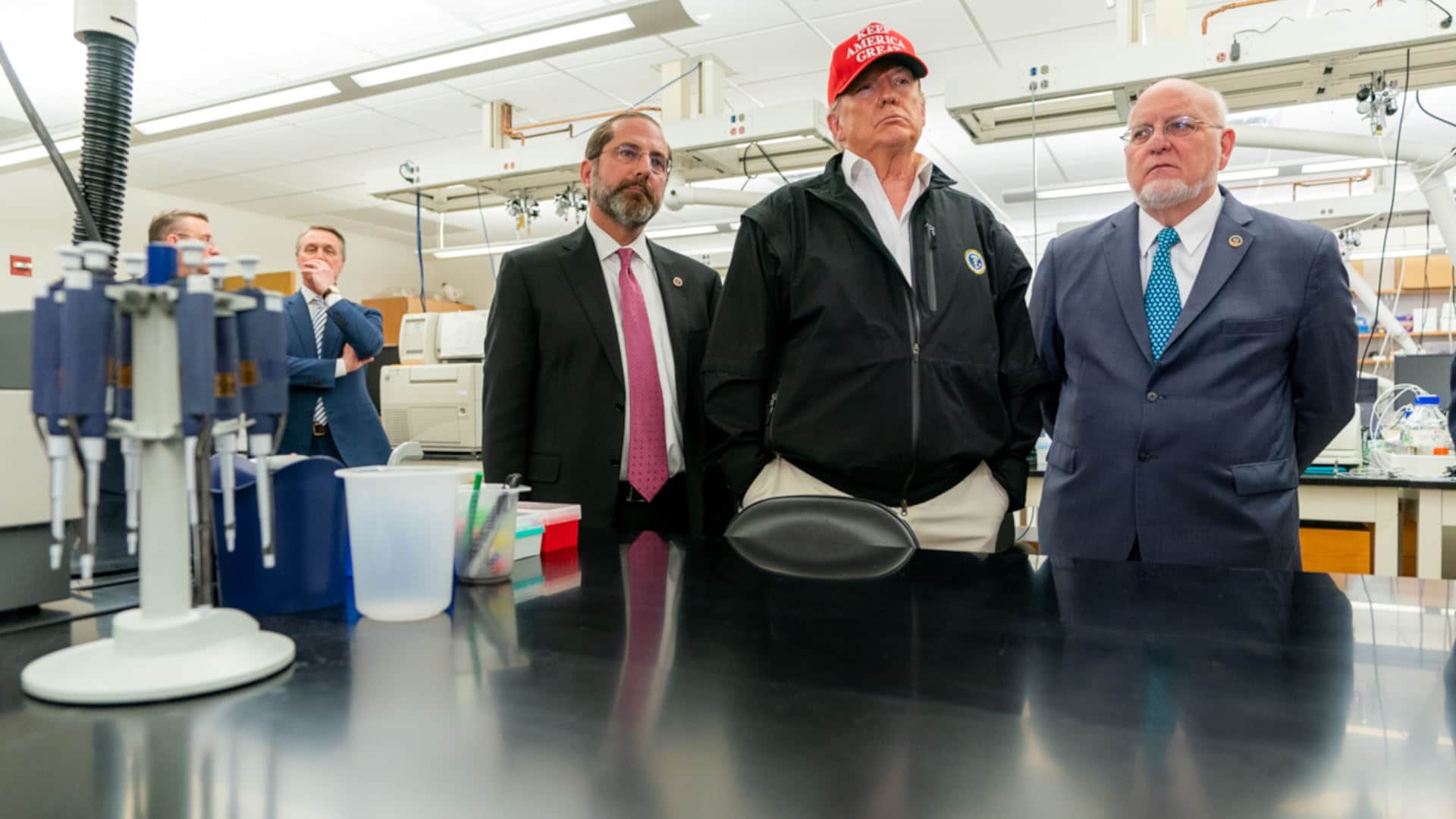On Wednesday, U.S. hospitals began sending daily Covid-19 data reports to a new database in Washington, bypassing the Centers for Disease Control and Prevention and prompting backlash from some public health experts, hospital leaders, journalists, and others who work with the data.
The new policy, posted in a document on the Department of Health and Human Services website, was first reported by The New York Times on Tuesday.
In March, hospitals began submitting the daily reports — which tally available beds, the number of patients with confirmed or suspected Covid-19 cases, and stocks of personal protective equipment, among other metrics that gauge preparedness and Covid-19 impacts — to the National Health Care Safety Network (NHSN), an established tool run by the CDC.
The new system was set up by a private contractor, and it is not overseen by the CDC. The update arrives at a time when many experts have expressed concern that the agency is being sidelined or politicized by President Donald J. Trump’s administration in the midst of a pandemic that has killed an estimated 138,360 people in the U.S.
“Collecting and reporting public health data is a core function of the CDC, for which the agency has the necessary trained experts and infrastructure,” Thomas File, the president of the Infectious Diseases Society of America, wrote in a statement on Tuesday. “Placing medical data collection outside of the leadership of public health experts could severely weaken the quality and availability of data, add an additional burden to already overwhelmed hospitals, and add a new challenge to the U.S. pandemic response.”
Federal officials defended the changes on Wednesday, suggesting that the backlash was overblown. The new system, CDC director Robert Redfield said Wednesday, would allow for more efficient data collection. “Streamlining reporting,” he said, “enables us to distribute scarce resources using the best possible data.” In addition, he said, “no one is taking access or data away from CDC.”
On Twitter, epidemiologist Mary-Margaret Fill pointed out that hospital data submission procedures have already changed several times since March, and stressed that the CDC would still have access to the data — even as she questioned the choice to give up an “opportunity to improve an existing surveillance system” in order to “stand up a new and unproven system mid-pandemic.”
Amid the swirling confusion about the change, many analysts are concerned about whether the hospital data, which is used to support such popular trackers as Covid Exit Strategy, will remain available to researchers outside of the federal government.
Indeed, Redfield’s remarks did not specify whether the hospital data would still be available to the public, and it remains unclear how the new system will affect access. On Tuesday, some hospital data on the CDC’s website had already disappeared, fueling concerns that the new reporting system would make it more difficult for experts and journalists to access basic information about the pandemic’s spread and impact.
And, on Thursday morning, the CDC’s hospital capacity dashboard went offline. Redfield “has said CDC still has access to the data but apparently the public no longer does,” investigative journalist Charles Ornstein wrote on Twitter. A few hours later, the dashboard returned — along with a note explaining that it would no longer be updated.
Also in the News:
• Twitter was gripped Wednesday afternoon by a large and unprecedented security breach involving the accounts of several high-profile users, including presumptive Democratic presidential nominee Joe Biden and Amazon CEO Jeff Bezos, as well as multinational corporations like Apple and Uber. The hacked accounts all tweeted similar messages instructing their followers to send money to a number of bitcoin wallets, which have since accumulated nearly $118,000, although it is difficult to tell who is sending the money. While the social media platform removed the fake tweets within minutes, the company temporarily shut down part of the network Wednesday evening as it worked to contain the breach, leaving many verified users (denoted by a blue check mark) unable to tweet for several hours. The company reported later Wednesday evening they believed that the hackers gained entry to the accounts through “a coordinated social engineering attack” on Twitter employees who had access to the platform’s internal controls. Twitter says it is still investigating the attack, and experts say it’s likely U.S. government agencies will soon launch probes of their own. The nature of the attack — brazen, but with a relatively small payout — has many cybersecurity experts worried that the hackers may execute another, more nefarious scheme. As Kenn White, a security principal at the software database company MongoDB, asked CNN: “If you’ve stolen a Ferrari, why just drive around the block?” (The Washington Post, CNN)
• More than 1,200 CDC employees signed onto a letter released this week describing systemic racism at the agency. The letter, addressed to CDC director Robert Redfield, says that Black employees “routinely experience bullying, excessive criticism, hostility, implicit bias, and overt racism from White colleagues with little recourse.” A CDC spokesperson acknowledged that Redfield had received the letter, which was also circulated to the agency’s 11,000 person workforce, but did not suggest that any action was forthcoming. The letter makes seven main recommendations for change, including increasing the number of Black people in senior leadership, taking direct action against the agency’s “toxic culture of exclusion and racial discrimination,” and declaring racism to be a public health crisis. While current CDC employees were not authorized to speak on the record, former agency officials said the timing of the letter was driven in part by the Covid-19 pandemic’s disproportionate toll on people of color, and by perceptions that the federal government has failed to adequately address that disparity. Greg Millet, a former senior scientist at the agency, told NPR that “CDC has been MIA on race and Covid-19.” (NPR)
• The top presidential contenders are staking out their positions on climate policy and environmental regulation, and the contrasts could hardly be more stark. On Tuesday, Joe Biden announced a plan to invest $2 trillion over four years to develop clean energy and combat climate change. Although the plan stops short of some measures proposed by Rep. Alexandria Ocasio-Cortez and Sen. Ed Markey in the Green New Deal, it is more ambitious than a proposal Biden released during the primary race. In addition to a pledge to rejoin the Paris Agreement, the plan calls for the U.S. to reach net-zero greenhouse gas emissions by 2050 and for power plants to be carbon free by 2035. Speaking in Atlanta on Wednesday, President Trump derided his rival’s proposal, saying that Biden “wants to massively re-regulate the energy economy.” Trump used the occasion to announce new rollbacks to a long-standing environmental rule, the National Environmental Policy Act. The new policy will relax requirements to consider the environmental and climate impacts of new infrastructure projects, and create steeper hurdles for community members who wish to register concerns. Although the rule rewrite is largely being praised by industry, critics say it could be particularly damaging to poor communities and communities of color. (The New York Times)
• A study published on Tuesday in the medical journal The Lancet forecast global fertility rates to drop substantially by the end of the 21st century. The study, conducted by researchers from the University of Washington’s Institute for Health Metrics and Evaluation, also predicted that by the end of this century 23 countries, including South Korea and Spain, would see their populations reduced by half. The predicted declines fit into a larger pattern: In 2017, the global fertility rate was estimated at an average of 2.4 children per woman, down from 4.7 children per woman in 1950. According to the study’s authors, by the year 2100 this rate is expected to drop below 1.7. The projections, though, vary widely by region. The study’s authors, for example, project that the population of sub-Saharan Africa will triple by the start of the 22nd century. Rather than issues with fertility, researchers say the overall decline is being driven by advances in education and work for women, as well as improved access to contraception. While a reduction in the world population may bode well for the environment, researchers say the imbalance of young people and an aging population could have massive social and economic consequences in the future. (BBC News)
• Critics expressed alarm this week that President Trump has been skirting Senate confirmations and filling senior positions at the Department of Defense with partisan loyalists — many of them apparently lacking the baseline academic or scientific credentials that would seem requisite for such high-level roles. While numerous executive positions at the Pentagon are currently unfilled — often a result of rooting out those seen as disloyal, according to a Politico report published Friday morning — candidates for such roles would normally require approval from the Senate. But the White House has been able to exploit obscure loopholes in federal vacancy rules to install “acting” personnel, Politico reported. These have included the assignment, announced Monday, of a White House technology officer, Michael Kratsios, to replace Michael Griffin, a former NASA administrator with a Ph.D. in aerospace engineering, as DoD’s head of research and engineering. Kratsios, Politico reports, has a bachelor’s degree in political science. While some Republicans defended the assignment and others like it, one expert on civil-military relations told Politico that “the criterion that seems to be getting these particular young, inexperienced people in is personal loyalty to the president.” Democratic Sen. Richard Blumenthal of Connecticut was more blunt: “This is a threat to our national security,” he said. (Politico)
• And finally: As some U.S. officials and members of the public continue to push back against orders requiring them to wear masks, a study published by the CDC on Tuesday provided further evidence that the face coverings work to help curb the spread of Covid-19. In May, two hairstylists at a Great Clips salon in Springfield, Missouri, fell ill but continued to report to work before testing positive and being sent home. Together, they had come into close contact with 139 clients during that time. However, patrons and staff has worn masks during the appointments. When contact tracers reached everyone who had been exposed and asked them to self-quarantine for 14 days, none reported any illness. And of the 67 who agreed to get tested for Covid-19, none were positive. “I was shocked,” Kendra Findley, one of the study authors, told The New York Times. While other researchers caution that the results should be taken with a grain of salt and cannot be generalized to situations where people are spending longer periods together indoors, many are hopeful that people will be encouraged by the findings and mask up. (The New York Times)
“Also in the News” items are compiled and written by Undark staff. Lucas Haugen, Deborah Blum, Jane Roberts, Frankie Schembri, Ashley Smart, and Tom Zeller Jr. contributed to this roundup.










